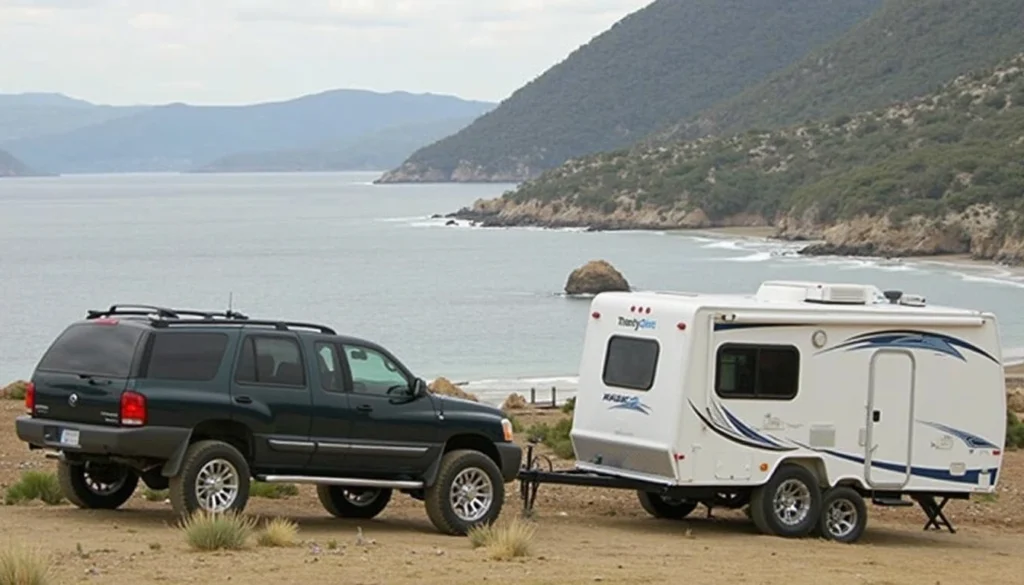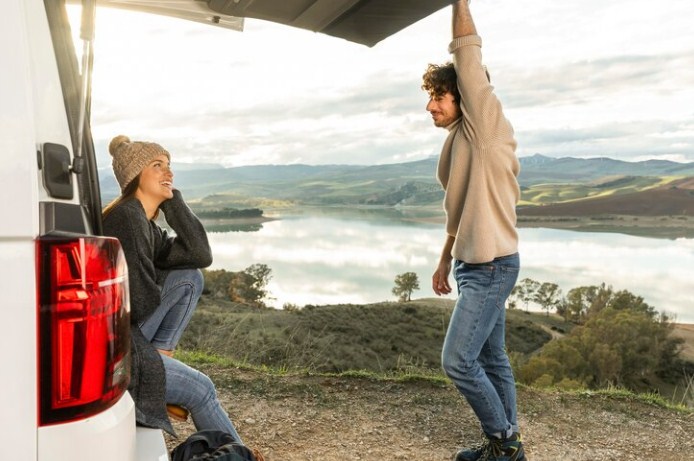
Tips For Backing Up A Travel Trailer embarking on a journey with a travel trailer in tow can be an exhilarating experience, opening up a world of adventure and exploration. However, one of the challenges that often daunt both novice and seasoned travelers alike is the art of backing up a travel trailer. Maneuvering a rig in reverse requires skill, patience, and a good understanding of some key tips to ensure a smooth and stress-free experience. In this article, we’ll delve into valuable insights and techniques to help you master the art of backing up your travel trailer with confidence.
Table of Contents
Practice in an Open Space: Mastering Trailer Maneuvers Before You Hit the Road

Before embarking on your travel trailer adventure, take the time to hone your backing-up skills in an open space. Finding an empty parking lot or open area provides an ideal environment to familiarize yourself with how the trailer responds to your steering inputs. This practice session is invaluable for building confidence and refining your technique without the added pressure of obstacles or confined spaces.
Why Practice in an Open Space
- Get a Feel for Trailer Response:
- An open space allows you to experiment with steering inputs and observe how the trailer reacts. Understanding the nuances of your trailer’s behavior is crucial for navigating various situations on the road.
- Simulate Real-Life Scenarios:
- Use markers or existing lines on the pavement to create simulated scenarios, such as a campground or tight parking spot. This helps you replicate the challenges you might encounter during your travels.
- Refine Techniques Without Pressure:
- Practicing in a spacious area eliminates the stress of potential obstacles or tight spaces. It creates a low-stakes environment where you can focus solely on improving your skills without the fear of causing damage.
Tips for Effective Practice:
- Set Up Markers:
- Create a makeshift course using cones, markers, or other objects to simulate the boundaries of a campground or parking area. This provides a visual guide for refining your precision and spatial awareness.
- Use Existing Lines:
- Many parking lots have painted lines that can serve as reference points. Utilize these lines to practice aligning your trailer within specific boundaries, enhancing your ability to navigate designated spaces.
- Experiment with Different Maneuvers:
- Take advantage of the open space to practice various maneuvers, such as straight-line backing, angled parking, and parallel parking. This comprehensive approach helps you develop a well-rounded set of skills.
- Gradually Increase Difficulty:
- Start with simple maneuvers and gradually progress to more challenging scenarios. As you become more comfortable, increase the complexity of your practice sessions to build confidence in handling different situations.
Navigating the Rearview with Confidence in Your Travel Trailer

When it comes to backing up a travel trailer, your side mirrors are your greatest allies. Mastering the art of using them effectively can significantly enhance your maneuvering skills. Properly adjusted mirrors provide a clear view of the sides and rear of your rig, offering invaluable insights into your trailer’s position in relation to obstacles and the surrounding environment.
The Importance of Mirror Usage:
- Enhanced Visibility:
- Side mirrors extend your field of vision, allowing you to see beyond the confines of your vehicle. This expanded view is crucial when navigating tight spots, avoiding obstacles, and ensuring the safety of your trailer.
- Better Spatial Awareness:
- By relying on your mirrors, you gain a better sense of the spatial relationship between your travel trailer and the surrounding environment. This awareness is essential for making precise adjustments and avoiding potential hazards.
- Real-Time Feedback:
- Mirrors provide real-time feedback on the movement of your trailer. Observing the trailer’s position and alignment through the mirrors allows you to make immediate corrections, contributing to smoother and more controlled backing maneuvers.
Tips for Effective Mirror Usage:
- Proper Adjustment:
- Before hitting the road, take the time to adjust your side mirrors properly. Ensure that you have a clear view of the sides and rear of your trailer. This step is crucial for maximizing the effectiveness of your mirrors during the journey.
- Regularly Check Blind Spots:
- While relying on mirrors is essential, periodically check your blind spots by turning your head to get a complete picture of your surroundings. This additional precaution ensures that you don’t miss any potential obstacles.
- Understand Mirror Coverage:
- Familiarize yourself with the coverage areas of your mirrors. Different mirrors may have varying fields of view, so understanding their limitations is essential for making informed decisions during backing maneuvers.
- Use Convex Mirrors:
- Consider using convex mirrors to further expand your field of vision. Convex mirrors are designed to provide a wider angle, minimizing blind spots and improving overall visibility.
The Golden Rule of Going Slow and Steady While Backing Up Your Travel Trailer

When it comes to the delicate art of backing up a travel trailer, the golden rule is clear: go slow and steady. In this intricate maneuvering process, prioritizing precision over speed is paramount. Employ gentle steering inputs and move at a crawl, affording yourself ample time to make necessary adjustments along the way.
The Significance of Going Slow and Steady:
- Precision Takes Precedence:
- Backing up a travel trailer requires precision, and this is best achieved at a slower pace. Rushing the process can lead to errors and compromises in accuracy. By moving at a measured speed, you gain better control over the trailer’s alignment.
- Minimize the Margin for Error:
- Operating at a slow and steady pace minimizes the margin for error. It allows you to detect and address any deviations from your intended path promptly. This methodical approach is especially crucial in confined spaces or when navigating around obstacles.
- Ample Time for Adjustments:
- Going slow provides you with the luxury of time to make calculated adjustments. Whether it’s a minor steering correction or realigning the trajectory of the trailer, moving at a crawl allows for careful, thoughtful maneuvers.
- Enhanced Safety:
- Slow and steady movements contribute to a safer backing experience. It gives both the driver and any potential spotters more reaction time, reducing the risk of collisions or accidental damage to the trailer or surrounding objects.
Tips For Backing Up A Travel Trailerand Steady Maneuvers:
- Prioritize Control Over Speed:
- Emphasize maintaining control rather than achieving speed. This mindset shift is fundamental to successful backing, fostering a methodical and deliberate approach.
- Practice Patience:
- Patience is key when backing up aTips For Backing Up A Travel Trailer. Embrace the learning process and resist the urge to rush. With practice, you’ll become more adept at navigating challenging situations with ease.
- Use Incremental Steering Inputs:
- Instead of making abrupt steering movements, opt for incremental inputs. Small, measured adjustments are easier to control and allow for a more gradual correction if needed.
- Engage in Regular Practice:
- Regular practice in various scenarios enhances your comfort and skill level. Familiarity with your trailer’s response at different speeds builds confidence, making slow and steady maneuvers second nature.
The Importance of Having a Spotter While Backing Up Your Travel Trailer
When it comes to the intricate dance of backing up a travel trailer, enlisting the assistance of a spotter can make all the difference. Clear communication between the driver and the spotter is crucial for a seamless maneuvering experience. Establishing a set of hand signals or utilizing a communication device ensures mutual understanding, allowing the spotter to provide real-time feedback on your trailer’s position and significantly enhancing the overall process.
The Role of a Spotter:
- Guidance and Direction:
- A spotter serves as your extra set of eyes on the ground. Their primary role is to guide and direct you as you navigate the challenges of backing up a travel trailer. With their assistance, you can confidently maneuver in tight spaces or tricky situations.
- Real-Time Feedback:
- The spotter provides immediate feedback on the trailer’s position, allowing you to make timely adjustments. This real-time information is invaluable, especially when dealing with blind spots or obscured views from the driver’s seat.
- Enhanced Safety:
- Having a spotter enhances safety by reducing the risk of collisions or accidental damage. Their presence allows for a more comprehensive awareness of the surroundings, minimizing the chance of overlooking potential obstacles.
Establishing Clear Communication:
- Hand Signals:
- Establish a set of clear and easily understood hand signals. These signals should cover essential directions such as “left,” “right,” “stop,” and “straight back.” Consistency in using these signals ensures a smooth flow of communication between the driver and the spotter.
- Communication Devices:
- In addition to hand signals, consider using communication devices such as two-way radios or smartphones with speaker functions. This allows for verbal communication, which can be particularly helpful in noisy or distant environments.
- Pre-Set Signals:
- Before embarking on your journey, pre-set signals with your spotter. Ensure that both of you are on the same page regarding the meanings of each signal. This proactive approach minimizes confusion and promotes efficient communication.
- Eye Contact:
- Maintain eye contact with your spotter whenever possible. This visual connection enhances non-verbal communication and fosters a sense of teamwork, further solidifying your ability to work in tandem.
Tips for Effective Spotter Collaboration:
- Select an Experienced Spotter:
- Choose a spotter with some experience or familiarity with guiding Tips For Backing Up A Travel Trailer. This ensures a more effective collaboration, as they will understand the nuances of trailer movements.
- Practice Together:
- Conduct practice sessions with your spotter in various scenarios. Familiarity with each other’s communication style and tendencies builds a level of trust that is essential for successful teamwork.
- Rotate Roles:
- Switch roles occasionally, allowing both the driver and spotter to experience each other’s perspective. This firsthand insight fosters a deeper understanding of the challenges faced by both parties.
The Art of Jackknife Recovery for Travel Trailer Enthusiasts
In the realm of travel trailer maneuvering, understanding and practicing jackknife recovery is a crucial skill that can make the difference between a minor hiccup and a potential disaster. A jackknife occurs when the trailer swings out at a sharp angle to the towing vehicle, presenting a challenge that demands quick and precise action. Counterintuitively, steering toward the jackknife is the key to regaining control and aligning the trailer with the towing vehicle. Regular practice in a controlled environment is essential to develop the muscle memory required to react swiftly in the event of a jackknife.
Why Jackknife Recovery Matters:
- Swift Reaction to Sharp Angles:
- In a jackknife scenario, time is of the essence. Knowing how to react promptly and effectively is crucial to prevent the trailer from reaching an extreme angle. Jackknife recovery techniques empower drivers to regain control swiftly.
- Counterintuitive Steering Technique:
- The counterintuitive nature of jackknife recovery can catch some drivers off guard. Steering toward the jackknife may seem contrary to instinct, but it is the most effective method to bring the trailer back in line with the towing vehicle.
- Avoidance of Potential Accidents:
- Proficient jackknife recovery minimizes the risk of accidents and damage to the trailer or surrounding objects. By mastering this skill, drivers can navigate challenging situations with confidence and composure.
Steps for Effective Jackknife Recovery:
- Maintain Calmness:
- In the event of a jackknife, staying calm is paramount. Panicking can lead to hasty decisions. Take a deep breath, assess the situation, and prepare to implement the recovery technique.
- Steer Toward the Jackknife:
- Counterintuitively, steer toward the direction of the jackknife. This action helps straighten out the trailer and prevents it from reaching an extreme angle. The goal is to bring the Tips For Backing Up A Travel Trailer back in line with the towing vehicle.
- Control Speed:
- Gradually reduce your speed as you steer toward the jackknife. Controlled deceleration is essential to prevent further escalation of the situation.
- Monitor Trailer Alignment:
- Keep a close eye on the alignment of the Tips For Backing Up A Travel Trailer as you execute the recovery technique. Adjust your steering inputs as needed to ensure that the trailer returns to a stable and controlled position.
Importance of Regular Practice:
- Develop Muscle Memory:
- Regularly practicing jackknife recovery in a controlled environment helps develop the muscle memory needed to react quickly and instinctively. This familiarity can be invaluable in a real-life situation.
- Build Confidence:
- Confidence is key when it comes to Tips For Backing Up A Travel Trailer maneuvering. Practicing jackknife recovery builds confidence in your ability to handle challenging scenarios, contributing to a more relaxed and composed driving experience.
- Enhance Overall Skill Set:
- Jackknife recovery is just one aspect of a comprehensive skill set for trailer maneuvering. Regular practice contributes to a well-rounded proficiency, making you a more capable and confident driver.
Understanding Your Travel Trailer’s Pivot Point for Confident Backing
In the intricate dance of travel trailer maneuvering, grasping the concept of the pivot point is fundamental to achieving success while backing up. Every travel Tips For Backing Up A Travel Trailer has a specific spot, known as the pivot point, around which it turns. This pivotal knowledge, combined with an awareness of its relation to your vehicle’s rear axle, is key to executing successful backing maneuvers. As you practice, paying close attention to how the trailer responds to your steering inputs becomes a valuable skill, allowing you to anticipate its movements with greater accuracy.
The Significance of Knowing Your Trailer’s Pivot Point:
- Precision in Maneuvering:
- The pivot point is the axis around which your trailer rotates during turns and backing. Understanding this point in relation to your vehicle’s rear axle provides valuable information for making precise steering inputs.
- Anticipating Trailer Movements:
- Knowing the pivot point allows you to anticipate how the trailer will respond to your steering actions. This anticipation is crucial for making timely adjustments and maintaining control during backing maneuvers.
- Enhanced Spatial Awareness:
- Awareness of the pivot point enhances your spatial awareness, helping you visualize the trailer’s trajectory. This knowledge is particularly valuable in confined spaces or when navigating around obstacles.
Steps to Learn and Apply Your Trailer’s Pivot Point:
- Identify the Pivot Point:
- Begin by identifying the pivot point on your travel trailer. This is typically near the center of the trailer, but factors likeTips For Backing Up A Travel Trailer length and axle placement can influence its precise location.
- Understand Relation to Rear Axle:
- Know the distance and direction from the trailer’s pivot point to your vehicle’s rear axle. This understanding is crucial for making accurate steering decisions during backing maneuvers.
- Practice Observant Steering:
- During practice sessions, pay close attention to how theTips For Backing Up A Tips For Backing Up A Travel Trailer responds to your steering inputs. Observe how the pivot point influences the trailer’s path and use this information to refine your technique.
- Anticipate Turning Radii:
- Familiarize yourself with the turning radii of your trailer based on its pivot point. This knowledge helps you predict the trailer’s path and avoid unexpected obstacles or tight spots.
Importance of Regular Practice:
- Refine Your Technique:
- Regular practice is essential for refining your understanding of the pivot point and honing your ability to anticipate the trailer’s movements accurately. The more you practice, the more intuitive these adjustments become.
- Build Confidence:
- Confidence in your ability to handle backing maneuvers grows with each practice session. Understanding and mastering the pivot point contributes to a sense of control and assurance on the road.
- Adapt to Different Trailers:
- If you switch between different trailers, adjusting to each one’s unique pivot point is crucial. Regular practice facilitates adaptability, allowing you to confidently handle various trailer configurations.
Leveraging Technology for Effortless Travel Trailer Backing
In the ever-evolving landscape of Tips For Backing Up A Travel Trailer navigation, modern technology has emerged as a valuable ally, offering a range of aids to simplify the often intricate task of backing up. Consideration for installing a backup camera system is a prime example of how these technological advancements can enhance the backing process. Providing real-time visuals of the Tips For Backing Up A Travel Trailer position, and in some cases, offering alignment guidelines, these systems prove to be invaluable tools. While it’s crucial to acknowledge that technology should not entirely replace traditional skills, it undeniably serves as a powerful complement, merging innovation with time-tested expertise.
The Evolution of Backing Assistance:
- Real-Time Visual Feedback:
- Backup camera systems deliver real-time visual feedback, granting drivers an unobstructed view of the trailer’s position. This instantaneous information significantly reduces blind spots and enhances overall visibility during the backing process.
- Guidelines for Alignment:
- Some advanced systems go a step further by providing alignment guidelines on the display screen. These virtual markers assist drivers in precisely aligning the trailer with their intended path, facilitating more accurate and controlled maneuvers.
- Enhanced Safety:
- The integration of technology in trailer navigation contributes to enhanced safety. By minimizing the reliance on mirrors alone, drivers can make more informed decisions, thereby reducing the risk of collisions, especially in challenging scenarios.
Balancing Technology with Traditional Skills:
- Complementing Skills:
- While technology offers valuable assistance, it should complement rather than replace traditional skills. Proficiency in fundamental backing techniques remains essential, ensuring that drivers can navigate confidently in any situation.
- Maintaining Spatial Awareness:
- Relying solely on technology may lead to a loss of spatial awareness. It’s crucial for drivers to maintain a comprehensive understanding of their surroundings, incorporating both visual information from the camera system and their own situational awareness.
- Adaptability Across Vehicles:
- Drivers should be adaptable to various trailers, each with its unique characteristics. Technology aids can enhance adaptability, but the ability to apply skills across different scenarios remains a hallmark of a skilled travel trailer navigator.
Choosing the Right Technology:
- Quality Backup Camera Systems:
- Invest in a high-quality backup camera system with features that align with your specific needs. Look for systems that offer clear visuals, wide-angle views, and, if possible, guidelines for alignment.
- Consider Additional Sensors:
- Some systems come equipped with additional sensors that provide audible alerts or warnings about obstacles in the trailer’s path. These sensors can be valuable supplementary tools for enhanced safety.
- Regular Maintenance and Updates:
- Ensure that your technology is well-maintained and updated regularly. Software updates and proper maintenance are essential to maximize the effectiveness of these systems.
| Article Topic | Key Takeaways |
|---|---|
| Practice in an Open Space: | – Practice in an open space before hitting the road. – Use empty parking lots to simulate tight spots. – Set up markers for a campground-like experience. – Refine backing techniques without the pressure of obstacles. |
| Use Your Mirrors: | – Side mirrors are crucial for successful backing. – Adjust mirrors properly for a clear view. – Gain a better sense of the trailer’s position in relation to obstacles. – Rely on mirrors for real-time feedback during maneuvers. |
| Go Slow and Steady: | – Backing up a trailer requires a slow and steady pace. – Precision is prioritized over speed. – Use gentle steering inputs. – Move at a crawl for ample adjustment time. |
| Have a Spotter: | – Enlist a spotter for guidance during backing. – Clear communication between driver and spotter is crucial. – Establish hand signals or use communication devices. – Spotter provides real-time feedback on the trailer’s position. |
| Practice Jackknife Recovery: | – Understand how to recover from a jackknife situation. – In a jackknife, steer toward it to bring the trailer back in line. – Regular practice in a controlled environment is essential. – Develop muscle memory for quick reactions. |
| Learn Your Trailer’s Pivot Point: | – Identify the pivot point of your travel trailer. – Know its relation to your vehicle’s rear axle. – Practice and pay attention to how the trailer responds to steering inputs. – Anticipate movements more accurately. |
| Utilize Technology: | – Modern technology aids in backing up. – Consider installing a backup camera system. – Backup cameras offer real-time visuals of the trailer’s position. – Some systems provide alignment guidelines. – Technology complements traditional skills but shouldn’t replace them entirely. |
frequently asked questions (FAQ) and their respective answers based on the article:
1. Practice in an Open Space:
- Q: Why is practicing in an open space essential for backing up a travel trailer?
- A: Open space allows for skill development without the pressure of obstacles, helping to refine techniques and build confidence.
2. Use Your Mirrors:
- Q: How do mirrors contribute to successful backing?
- A: Mirrors provide enhanced visibility, offering a clear view of the trailer’s position, helping to navigate surroundings and obstacles more effectively.
3. Go Slow and Steady:
- Q: Why is going slow crucial when backing up a travel trailer?
- A: Precision is prioritized over speed, allowing for better control and the ability to make necessary adjustments with ample time.
4. Have a Spotter:
- Q: Why is having a spotter important during backing maneuvers?
- A: A spotter offers guidance and real-time feedback, enhancing safety and making the backing process smoother and more controlled.
5. Practice Jackknife Recovery:
- Q: What should be done in a jackknife situation?
- A: Steer toward the jackknife to bring the trailer back in line, and regular practice helps develop the muscle memory needed for swift reactions.
6. Learn Your Trailer’s Pivot Point:
- Q: Why is knowing the trailer’s pivot point important?
- A: Understanding the pivot point aids in making precise steering inputs, allowing for accurate backing maneuvers and better spatial awareness.
7. Utilize Technology:
- Q: How can technology aid in backing up a travel trailer?
- A: Backup camera systems provide real-time visuals and alignment guidelines, complementing traditional skills and enhancing overall safety.
Comprehensive Conclusion
Navigating a travel trailer demands a blend of traditional skills and modern technology, each playing a pivotal role in ensuring a smooth and controlled journey. Practicing in open spaces allows for skill refinement without the pressure of obstacles, fostering confidence in handling tight spots and crowded campgrounds. Utilizing side mirrors becomes an art in itself, offering enhanced visibility and real-time feedback crucial for precise maneuvers.
The mantra of “go slow and steady” echoes through the articles, emphasizing the importance of precision over speed. This deliberate approach provides the time needed for adjustments, turning the backing process into a methodical and controlled endeavor. Having a spotter by your side emerges as a collaborative dance, where clear communication and real-time feedback transform challenges into synchronized movements.
Jackknife recovery unveils the counterintuitive art of steering toward the problem, showcasing the significance of muscle memory developed through regular, controlled practice. Understanding the trailer’s pivot point adds a layer of finesse to maneuvering, allowing drivers to anticipate movements and navigate with precision.
Technology, in the form of backup camera systems, emerges as a modern ally, providing real-time visuals and alignment guidelines. However, the articles emphasize that these technological aids should complement, not replace, the foundational skills of a skilled travel trailer driver.
In conclusion, the mastery of travel trailer navigation lies in the harmonious integration of time-tested techniques, regular practice, a keen understanding of the vehicle and trailer dynamics, and the judicious use of technology. As enthusiasts embark on the open road, they carry with them a comprehensive toolkit, ensuring a journey marked by confidence, skill, and the thrill of the trail.

